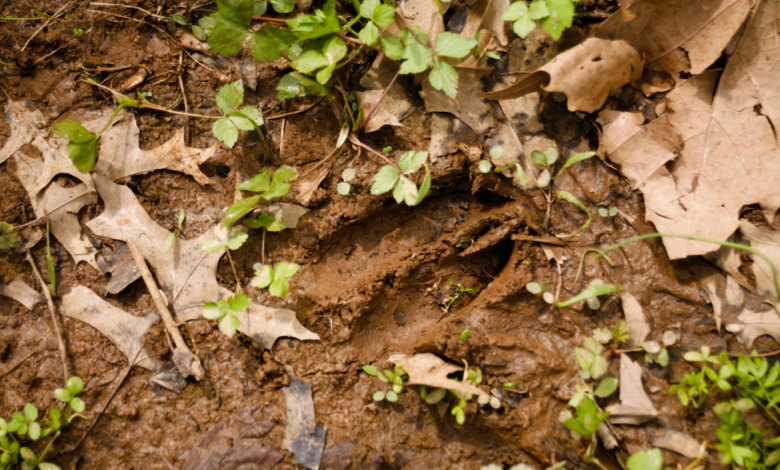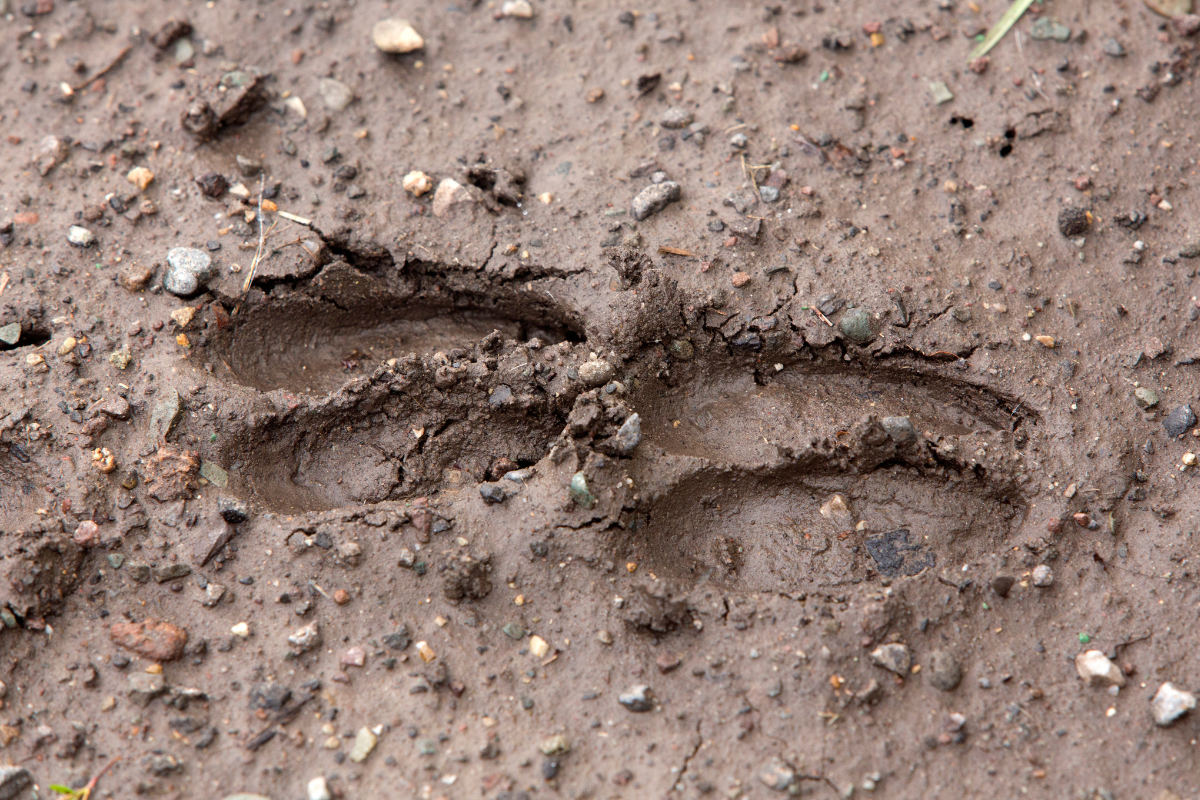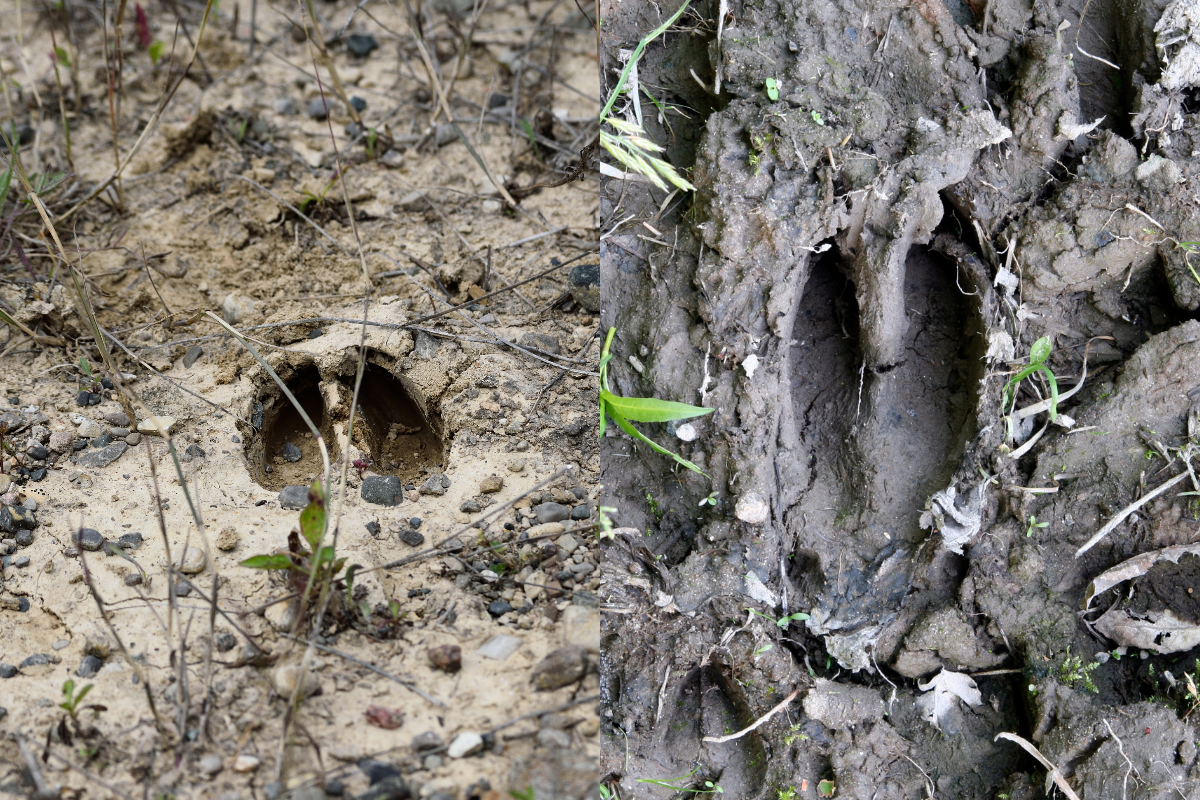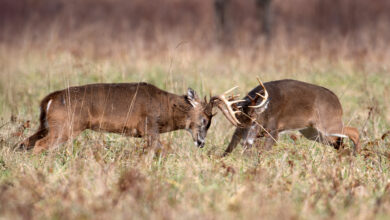Deer Tracks: What Do Deer Tracks Look Like and How to Use This Info

Trail cameras are incredibly useful, and I have to admit that I am a recent convert who loves using them. Simply set them up and the images will get transferred to your phone wirelessly. That way you do not need to leave your trail or smell on the hunting ground either.
With all the high-tech wizardry to help you scout, do you need old-school skills like reading deer tracks at all?
It is interesting how technical advancements can make hunters ignore fundamental tracking skills. By overlooking the deer tracks and other signs, you might be missing out on the vital clues left by the deer. And that can make a big difference during a hunt.
For some reason, following deer tracks and reading their signs in the wilderness makes me feel more connected to nature. Plus, by combining basic woodsmanship skills with technology, you can become a better hunter.
Want to learn more about deer tracks and tracking deer? Check out this episode with Randy Flannery:
Basics of Deer Tracks
Deer hooves are made from keratin, the same protein that creates our nails. The keratin makes the hooves super strong and more crack-resistant than bones. At the base of the hooves, there is a leathery pad that contacts the ground.
The hooves are attached to the bones of the legs through a special ligament. Similar to us, deer can spread their toes, and depending on the situation, the exact shape of their V-shaped tracks can vary.
Deer have four toes in their hooves – two large ones in the front and two smaller ones in the back called dewclaws. The front hooves are larger and split centrally. They show up as elongated and pointed marks, one beside the other, on a track.
Generally, the dew claws do not show up in the tracks of a walking whitetail deer, unless the animal is moving through mud or deep snow.
The shape of these toes differs from one deer species to another, making each track unique. If you are hunting in an area where other hoofed mammals exist along with deer, identifying tracks gets more challenging. Back in the day, I used to get confused between deer tracks and those of the pronghorn antelope and the mountain goat.
Note, the front tracks of a mature buck are larger than the hind tracks. The reason is simple- the front legs carry more weight. Also, the outside toe at the front tends to be longer, which can help you tell the left foot from the right. But this can vary from animal to animal.
The size and depth of the hooves can tell you a lot about the deer. While it is easier to spot an adult buck from a track, things get difficult when trying to differentiate the younger males from the does. Both have smaller tracks without any distinct visible difference.
Types of Deer Tracks
Here are some typical deer tracks that you will come across.
Walking tracks – Walking deer tracks have a neat outline and the soil around the tracks is undisturbed. In most cases, the dew claws do not touch the ground and the gap between the front toes is small.
Running tracks: Running tracks are deeper and you are likely to find the soil around the tacks to be scattered due to the impact. The gap between the front toes will be more and the dewclaws will be impacting the ground. Since the deer is moving forward quickly, the debris is thrown forward in running tracks.
Bedding tracks: In most cases, adult deer have more than one bedding area. It is difficult to find clear tracks on areas covered with acorns or on brush piles. Keep in mind that if you find multiple beds close to each other, they are doe and fawn beds.
Feeding tracks: Feeding areas are easier to identify through the tracks as you will find numerous tracks, often overlapping each other. Since the deer seem to move around casually in the area, tracks may seem to zigzag around aimlessly. Plus, there will be a lot of droppings in the area.

Identifying Deer Tracks
Now all that might sound easy, but in the real world, things are not so simple. Not all deer tracks are easily visible. Imprints can be ill-defined due to hard soil, and leaves, or can get washed out by rain.
When they are clearly visible, I focus more on the width of the tracks to spot the big bucks.
Typically, if the width of the front toes is between 3½ – 4 inches, or almost as wide as four fingers of your hand placed together, it indicates a buck that weighs over 200 pounds. Also, in a heavy buck, the hooves in the front legs will be splayed.
When you are tracking deer on soft soil, like mud or wet sand, the first thing you will notice is the large dots formed by the animal’s dew claws. If the dewclaw impressions are visible, check the gap between their outermost edges. If it is 3 inches or even more, this is a deer worth following.
Perhaps the easiest thing to find out from deer tracks is the direction of their travel. The front end of the toes come together, without actually meeting, to form a narrow point and indicate the direction of travel.
Just as mature bucks have unique antlers, their tracks are unique too. You may find a buck with a chipped hoof. I remember a large buck that I was following having cracked hooves that showed in the tracks. Most likely, it indicated that the deer had survived a viral infection.
I prefer carrying a flexible tape for scoring deer and using it to measure tracks. You can use steel tape measures or a folding ruler. While measuring, make sure to pick clear tracks.
What Deer Tracks Tell You
During my early days as a hunter, I was left mystified when someone could point out a buck’s track from a doe’s track. Even after decades of hunting and knowing the definite pointers that help in spotting the differences, I have to admit it is not so easy for newbies.
Different deer species have different track patterns. For example, Elks have a broader hoof print than whitetails. Reindeers have distinctive ‘half-moon’ shaped tracks with pronounced dew claws.
Keep in mind that there are other species like mountain goats, bighorn sheep, and pronghorn antelope. Differentiating between similar tracks of different species can be challenging, especially if the terrain is hard and the tracks are not distinct.
The length of the step increases as the deer starts running.
Walking stride length:
- Average whitetail: about 1 foot
- Trophy deer: about 2-2½ feet
- Bounding stride length: more than 15 feet
Track width is a more reliable indicator of age due to hoof tips breaking away as a deer ages.
Hoof width:
- Mature doe or a 2½-year-old buck: between 2 and 2½ inches
- As the buck ages, the back of the front toes makes a heavier impression on the ground than the toes.
If the soil is soft but the deer is taking very short steps and the marks are choppy, it can be in poor physical condition. If one particular track is smeared while the other three are more defined, the deer may have a broken leg. That said, for an average hunter making such judgment calls is not easy.
One key skill I have developed is the ability to age the tracks. The factors affecting a deer track’s aging are soil type, wind, rain, and the sun. If the soil type is soft clay, the marks will look fresh even after a few days. But the marks will dry out quickly if the soil is hard and loamy. Likewise, when deer move in the rain, the tracks left behind will not be distinct.
Look closer at the fine lines at the edges of the mark. Fresh tracks will have sharper details, while older ones will be faded or have broken pieces. If the weather is dry and the print is still moist, it can indicate a fresh print.
On a windless day, if you see excess debris inside the hoof print, it is an older track. Also, I punch my heel onto the ground beside the track and compare the two. If they look similar, the deer may not be too far ahead. Another tip – check the underside of any leaf lying on the tracks. Signs of condensation indicate that the track is not fresh.
Admittedly, the best way to scout for deer is to use all the signs that you find. That includes droppings, rubs, and scrapes along with the tracks. Once you learn to look for all these signs and combine them effectively, deer scouting gets much easier.

Buck vs Doe Tracks
There is a difference in size when you compare buck vs doe tracks. The total length of the track from the toe tip to the back of the dewclaw can be between 5 to 6 inches for a mature buck. The length of the front toes can be around 3-4 inches.
For adult doe and younger bucks, the track length can be 1 1⁄2 – 4 inches and the width can be between 1 1⁄2 – 2 1⁄2 inches. Beyond that, the bucks tend to dig out more dirt as they move.
While buck tracks tend to be larger than that of a doe or a juvenile male, deer sizes tend to vary between regions. So it is not possible to form a standard size cutoff.
Now, do not make the mistake of ignoring doe tracks, especially if you are hunting around the deer rutting season. Each doe can have a buck hanging around her in this period. Also, do not make decisions about the herd demography from a few feet of track marks. Follow the tracks for a relatively long period to learn about the herd demographics.
Final Thoughts
Making a quick distinction between mule deer vs whitetail deer from their tracks is not a skill that you can pick up quickly. It takes patience and practice to identify the species and derive the right details from a track.
But, once you learn how to identify whitetail deer tracks, your skills in the whitetail woods will go up. Combining your tracking skills with the power of cameras and hunting apps can be a deadly mix for notching more tags.


